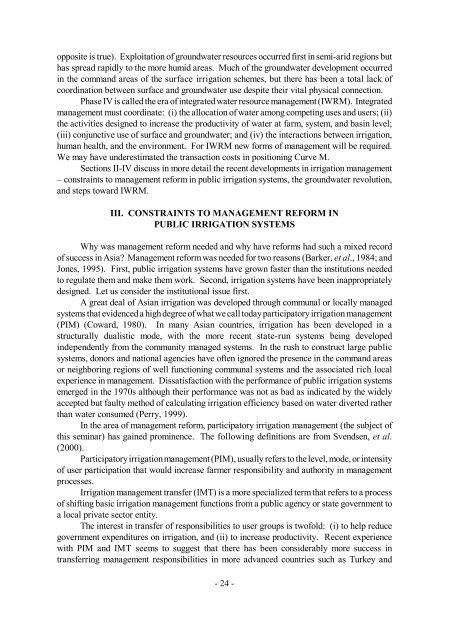Organizational Change for Participatory Irrigation Management
Organizational Change for Participatory Irrigation Management
Organizational Change for Participatory Irrigation Management
You also want an ePaper? Increase the reach of your titles
YUMPU automatically turns print PDFs into web optimized ePapers that Google loves.
opposite is true). Exploitation of groundwater resources occurred first in semi-arid regions but<br />
has spread rapidly to the more humid areas. Much of the groundwater development occurred<br />
in the command areas of the surface irrigation schemes, but there has been a total lack of<br />
coordination between surface and groundwater use despite their vital physical connection.<br />
Phase IV is called the era of integrated water resource management (IWRM). Integrated<br />
management must coordinate: (i) the allocation of water among competing uses and users; (ii)<br />
the activities designed to increase the productivity of water at farm, system, and basin level;<br />
(iii) conjunctive use of surface and groundwater; and (iv) the interactions between irrigation,<br />
human health, and the environment. For IWRM new <strong>for</strong>ms of management will be required.<br />
We may have underestimated the transaction costs in positioning Curve M.<br />
Sections II-IV discuss in more detail the recent developments in irrigation management<br />
– constraints to management re<strong>for</strong>m in public irrigation systems, the groundwater revolution,<br />
and steps toward IWRM.<br />
III. CONSTRAINTS TO MANAGEMENT REFORM IN<br />
PUBLIC IRRIGATION SYSTEMS<br />
Why was management re<strong>for</strong>m needed and why have re<strong>for</strong>ms had such a mixed record<br />
of success in Asia? <strong>Management</strong> re<strong>for</strong>m was needed <strong>for</strong> two reasons (Barker, et al., 1984; and<br />
Jones, 1995). First, public irrigation systems have grown faster than the institutions needed<br />
to regulate them and make them work. Second, irrigation systems have been inappropriately<br />
designed. Let us consider the institutional issue first.<br />
A great deal of Asian irrigation was developed through communal or locally managed<br />
systems that evidenced a high degree of what we call today participatory irrigation management<br />
(PIM) (Coward, 1980). In many Asian countries, irrigation has been developed in a<br />
structurally dualistic mode, with the more recent state-run systems being developed<br />
independently from the community managed systems. In the rush to construct large public<br />
systems, donors and national agencies have often ignored the presence in the command areas<br />
or neighboring regions of well functioning communal systems and the associated rich local<br />
experience in management. Dissatisfaction with the per<strong>for</strong>mance of public irrigation systems<br />
emerged in the 1970s although their per<strong>for</strong>mance was not as bad as indicated by the widely<br />
accepted but faulty method of calculating irrigation efficiency based on water diverted rather<br />
than water consumed (Perry, 1999).<br />
In the area of management re<strong>for</strong>m, participatory irrigation management (the subject of<br />
this seminar) has gained prominence. The following definitions are from Svendsen, et al.<br />
(2000).<br />
<strong>Participatory</strong> irrigation management (PIM), usually refers to the level, mode, or intensity<br />
of user participation that would increase farmer responsibility and authority in management<br />
processes.<br />
<strong>Irrigation</strong> management transfer (IMT) is a more specialized term that refers to a process<br />
of shifting basic irrigation management functions from a public agency or state government to<br />
a local private sector entity.<br />
The interest in transfer of responsibilities to user groups is twofold: (i) to help reduce<br />
government expenditures on irrigation, and (ii) to increase productivity. Recent experience<br />
with PIM and IMT seems to suggest that there has been considerably more success in<br />
transferring management responsibilities in more advanced countries such as Turkey and<br />
- 24 -
















